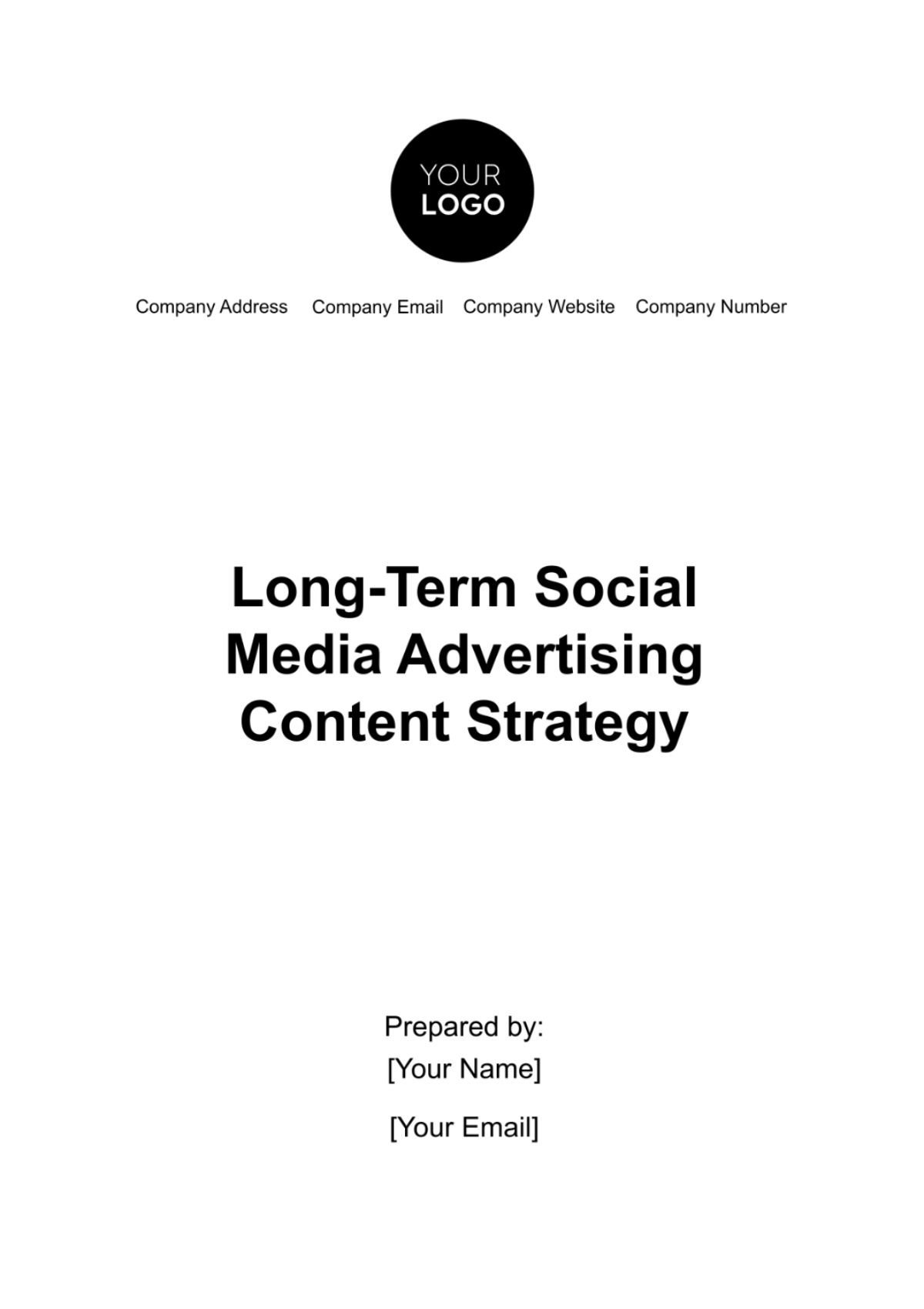Free Long-Term Social Media Advertising Content Strategy

I. Introduction
Background
In the dynamic landscape of digital marketing, establishing a compelling and enduring online presence is paramount for the success of any contemporary business. This Long-Term Social Media Advertising Content Strategy emerges as a response to the evolving nature of consumer engagement, where the interconnected realms of social media and advertising converge to form a powerful conduit for brand communication.
Objectives Of The Advertising Campaign
At the core of this strategy lies a meticulous alignment with overarching marketing goals. Whether the aim is to enhance brand visibility, drive website traffic, or bolster sales, each objective is carefully articulated, quantifiable, and designed to resonate with the broader business agenda. This section provides a foundational understanding of the strategic imperatives that propel the conception and execution of a comprehensive, long-term social media advertising initiative.
II. Audience Analysis
Demographic Profiling
In this critical phase, meticulous demographic profiling takes center stage. By delving into the intricacies of our audience's characteristics, such as age, gender, geographic location, and socio-economic status, we aim to construct a detailed profile that serves as the cornerstone for our tailored content strategy.
Behavioral Analysis
Beyond demographics, a thorough behavioral analysis becomes paramount. Understanding the intricacies of our audience's online behaviors, preferences, and interaction patterns equips us with the foresight to curate content that resonates deeply and fosters genuine engagement. This analysis encompasses their content consumption habits, preferred platforms, and response triggers.
Target Audience Identification
The culmination of demographic profiling and behavioral analysis leads to the precise identification of our target audience. By synthesizing this information, we gain a comprehensive understanding of the individuals we aim to connect with. This holistic view facilitates the crafting of content that not only captures attention but also establishes a meaningful connection, laying the foundation for a sustained and impactful social media presence.
III. Platform Selection
Evaluation of Social Media Platforms
In this crucial phase of our Long-Term Social Media Advertising Content Strategy, an in-depth evaluation of various social media platforms is imperative. This section meticulously examines the landscape, considering the unique features, user demographics, and engagement dynamics of each platform.
1. Demographic Profiling
Conduct a comprehensive demographic analysis to discern the primary user base of each platform. Scrutinize age groups, geographic locations, and socio-economic factors to align platform selection with the characteristics of our target audience.
2. Behavioral Analysis
Delve into the behavioral nuances exhibited by users on different platforms. Understanding user behaviors, such as content consumption habits, interaction preferences, and response patterns, is instrumental in tailoring our content strategy for maximum impact.
3. Target Audience Identification
Synthesize the findings from demographic profiling and behavioral analysis to pinpoint our target audience on each platform. Clearly defining our audience enables precision in content creation and ensures that our messaging resonates authentically with the intended recipients.
Platform-Specific Considerations
Tailoring our approach to the unique characteristics of each platform is paramount for success. This section outlines specific considerations for major social media platforms, including but not limited to Facebook, Instagram, Twitter, LinkedIn, and emerging platforms.
1. Facebook
Explore the multifaceted advertising options on Facebook, leveraging its extensive user base and versatile ad formats. Highlight strategies to engage users within the Facebook ecosystem and integrate seamlessly with their content consumption patterns.
2. Instagram
Capitalizing on the visual nature of Instagram, this subsection elucidates strategies for crafting visually appealing content. Address the nuances of Instagram's algorithm and explore opportunities for leveraging features like Stories, IGTV, and Reels.
3. Twitter
Navigate the fast-paced environment of Twitter with strategies that capture attention amidst the constant stream of information. Emphasize concise messaging, trending hashtags, and real-time engagement to foster meaningful connections.
4. LinkedIn
Tailor content for a more professional audience on LinkedIn, focusing on thought leadership, industry insights, and networking. Discuss the effectiveness of sponsored content, InMail, and other B2B-oriented features.
5. Emerging Platforms
Anticipate trends and evaluate the potential of emerging platforms, providing a framework for experimentation and early adoption. Stay attuned to the evolving digital landscape to position our brand at the forefront of innovation.
Selection Rationale
Summarize the findings from the evaluation process and articulate the rationale behind the selection of each platform. Justify how the chosen platforms align with the campaign objectives and target audience, emphasizing the anticipated impact on overall campaign performance.
IV. Content Calendar Development
The Content Calendar serves as the heartbeat of our Long-Term Social Media Advertising Content Strategy, meticulously organizing and scheduling the deployment of content across various platforms. This section delves into the intricacies of its development, ensuring a harmonious alignment with campaign timelines and overarching objectives.
Scheduling Strategy
Our scheduling strategy revolves around a balanced distribution of content to maintain consistent audience engagement without overwhelming them. This involves:
Frequency Analysis: Determining optimal posting frequencies based on platform algorithms, audience behavior, and content type.
Peak Engagement Times: Identifying and leveraging peak engagement periods to maximize content visibility and interaction.
Incorporation Of Relevant Events And Trends
To enhance content relevance and resonance, the calendar incorporates a strategic integration of relevant events and emerging trends. This entails:
Event Calendar: A dedicated section detailing upcoming events, holidays, and industry milestones that present opportunities for tailored content creation.
Trend Analysis: Regular monitoring of industry and social media trends, enabling the agile adaptation of content to capitalize on emerging topics.
Content Calendar Snapshot
Date | Content Type | Platform | Theme/Messaging | Call To Action |
2050-01-15 | Video | Product Showcase | Visit our website for exclusive offers | |
2050-01-20 | Blog Post | Industry Insights | Engage with us in the comments section | |
2050-01-25 | Infographic | Trend Analysis | Retweet and share your thoughts |
This snapshot exemplifies the detailed planning embedded in the Content Calendar, ensuring a seamless flow of diverse and compelling content across platforms. The incorporation of relevant events and trends ensures that our content remains timely, resonant, and aligned with the dynamic interests of our target audience.
V. Content Types And Formats
In the dynamic landscape of social media, the diversification of content types and formats is pivotal for capturing and retaining audience attention. This section delineates a strategic approach to crafting engaging content that resonates with the target audience across various platforms.
Diversification Strategy
To cater to the diverse preferences of our audience, our content strategy encompasses a judicious mix of multimedia elements. This includes:
Images: High-quality visuals to convey brand identity and evoke emotions.
Videos: Dynamic and shareable video content for conveying complex messages and storytelling.
Infographics: Visual representations of data and information for quick comprehension.
Textual Content: Well-crafted copywriting to communicate detailed information and maintain a consistent brand voice.
Visual And Textual Content Guidelines
Maintaining a cohesive visual identity is paramount. The following guidelines ensure consistency across all content formats:
Branding Elements: Incorporate logos, color schemes, and typography consistently.
Quality Standards: Ensure high-resolution images and videos for a polished and professional appearance.
Message Alignment: Align textual content with the overarching brand messaging and objectives.
Ensuring Consistency Across Formats
A structured approach to content creation involves developing a content calendar that strategically integrates different formats. This not only prevents monotony but also maximizes the impact of the message across the chosen platforms.
Content Diversification Table
Content Type | Purpose | Platform Suitability |
Images | Visual storytelling, brand representation | Instagram, Facebook, Pinterest |
Videos | Dynamic content, storytelling | YouTube, Facebook, Instagram |
Infographics | Data visualization, quick information | Twitter, LinkedIn, Instagram |
Textual Content | Detailed information, brand voice consistency | Blog posts, Facebook, LinkedIn |
This table provides a quick reference for aligning content types with their intended purposes and suitable platforms. By adhering to these guidelines and utilizing a diverse range of content formats, our strategy aims to captivate our audience, enhance brand recall, and foster sustained engagement over the long term.
VI. Brand Consistency
Maintaining A Unified Visual Identity
Harmonizing visual elements, including logo, color palette, and imagery, to present a cohesive brand image that resonates with the target audience.
Consistent Brand Voice And Messaging
Crafting a consistent and recognizable brand voice, tone, and messaging style across all social media platforms, reinforcing the brand's personality and values.
Reinforcing Brand Recognition
Implementing strategies to consistently reinforce and amplify the brand's visual and messaging elements, fostering increased recognition and trust among the audience.
VII. Monitoring And Analytics
Implementing Monitoring Tools
Leverage cutting-edge monitoring tools to systematically track the performance of social media content. Utilize advanced analytics platforms to gather real-time data, enabling a dynamic understanding of audience interactions, reach, and engagement.
Key Performance Metrics
Identify and prioritize key performance metrics, including but not limited to:
Engagement Rates
Impressions
Click-Through Rates (CTR)
Conversion Rates
Audience Growth
Establish benchmarks for each metric to gauge the success of the advertising content against predetermined objectives.
Regular Analysis And Reporting
Foster a culture of regular analysis and reporting. Conduct in-depth assessments of the gathered data to derive actionable insights. Generate comprehensive reports highlighting trends, successes, and areas for improvement. Facilitate informed decision-making by presenting stakeholders with clear, visually engaging reports that showcase the impact of the advertising content on overall campaign performance.
VIII. Adaptability And Optimization
The Adaptability and Optimization section underscores the dynamic nature of social media landscapes, emphasizing the need for a flexible approach to meet evolving trends and user expectations. This segment encompasses three crucial elements:
Flexibility In Response To Trends
In this subsection, we discuss the importance of staying attuned to emerging trends within the social media sphere. It advocates for a proactive stance, allowing for swift adjustments to content strategies in response to changing user behaviors and industry dynamics.
Optimization Based On Performance Data
This subsection delves into the significance of data-driven decision-making. It highlights the role of robust analytics in providing insights into the performance of advertising content. By systematically analyzing key metrics, the strategy can be refined and optimized to enhance effectiveness continually.
Experimentation And A/B Testing
The final subsection encourages a culture of experimentation. By conducting A/B testing and exploring alternative approaches, the strategy can identify optimal content formats and messaging styles. This iterative process ensures a continual refinement of the advertising content, maximizing its impact over the long term.
IX. Compliance With Policies And Guidelines
Platform-Specific Policies
To guarantee a seamless campaign execution, thorough awareness and adherence to the unique policies of each social media platform are imperative. This section outlines the platform-specific regulations and offers a strategic approach to ensure full compliance.
Guidelines Adherence Strategy
Establishing a robust strategy to adhere to guidelines is crucial for maintaining the integrity of the advertising content. This section provides a proactive approach to aligning content with platform guidelines, minimizing the risk of non-compliance.
Staying Informed About Algorithm Changes
In the dynamic landscape of social media, staying abreast of algorithmic shifts is paramount. This section presents a proactive methodology to stay informed, allowing for swift adjustments to the content strategy in response to any platform algorithm changes.
X. Budget Allocation
Overall Budget Planning
In the realm of Long-Term Social Media Advertising, meticulous budget planning is imperative. The allocation of financial resources should be approached with strategic precision, aligning with the overarching objectives of the campaign. Considerations must be given to both the breadth of the campaign and the duration over which the strategy will unfold.
Allocation Across Platforms
Different social media platforms have varied advertising costs and effectiveness. A judicious distribution of the budget across these platforms is crucial. Analyze the target audience's preferences and the platforms' unique strengths to optimize resource allocation. This section delves into a platform-specific breakdown, ensuring that each channel receives an allocation reflective of its potential impact.
Budget Allocation Table (Sample):
Social Media Platform | Allocation (%) | Rationale |
40 | Extensive user base and robust ad targeting. | |
Visual-centric content resonates with the audience. | ||
Real-time engagement and trending conversations. | ||
Professional network for B2B engagement. |
Return On Investment Analysis
This section focuses on the vital aspect of measuring the return on investment (ROI) for each allocated budget segment. By implementing key performance indicators (KPIs) and analytics tools, continuous evaluation will guide adjustments, ensuring the budget's effectiveness in achieving campaign goals. A detailed ROI analysis will be instrumental in refining the budget allocation strategy for optimal results.
XI. Conclusion
This Long-Term Social Media Advertising Content Strategy serves as a robust blueprint for navigating the dynamic landscape of digital marketing. By meticulously aligning objectives, understanding the nuances of target audiences, and strategically leveraging diverse content across chosen platforms, businesses can establish a resilient online presence.
The careful orchestration of a consistent brand identity, coupled with vigilant monitoring and adaptive optimization, forms the cornerstone of this strategy. Through adherence to platform policies, guidelines, and judicious budget allocation, organizations can not only mitigate risks but also capitalize on emerging opportunities.
In essence, this comprehensive guide empowers businesses to not only weather the ever-evolving social media terrain but also to flourish over time. As the digital realm continues to redefine how brands connect with their audience, this strategy positions organizations to not only survive but thrive in the intricate dance of long-term social media advertising.
- 100% Customizable, free editor
- Access 1 Million+ Templates, photo’s & graphics
- Download or share as a template
- Click and replace photos, graphics, text, backgrounds
- Resize, crop, AI write & more
- Access advanced editor
Discover the Long-Term Social Media Advertising Content Strategy Template on Template.net, your go-to platform for comprehensive marketing solutions. This editable and customizable tool empowers you to craft a strategic roadmap for sustained success. Utilize our Ai Editor Tool to refine your approach, ensuring relevance and engagement across platforms for lasting impact.
You may also like
- Instagram Ad
- Instagram Banner
- Instagram Frame
- Instagram Post
- Instagram Profile Picture
- Instagram Story
- Instagram Story Highlights
- Twitter Ad
- Twitter Header
- Twitter Post
- LinkedIn Photo
- Linkedin Post
- YouTube
- Youtube Ad
- Youtube Banner
- YouTube Channel Art
- YouTube End Screen
- Youtube Profile Photo
- YouTube Thumbnail
- Facebook Ad
- Facebook Cover
- Facebook Post
- Facebook Profile Frame
- Facebook Profile Photo
- Twitch Offline Banner
- Linkedin Banner
- Twitch Overlay
- Whatsapp Status
- Reddit Banner
- Social Media Banner
- Social Media Clipart
- Social Media Plan
- Social Media Contract
- Social Media Planner
- Social Media Report
- Social Media Agreement
- Social Media Business Card
- Social Media Proposal
- Social Media Presentation





























